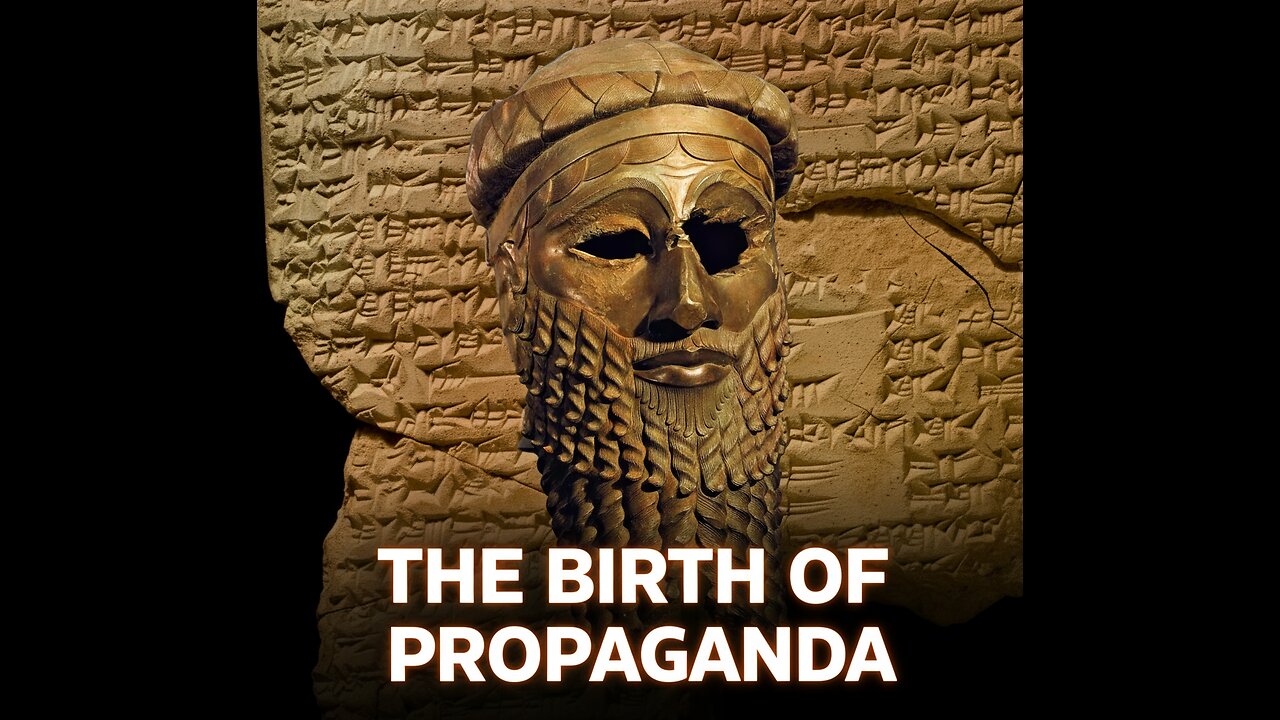Premium Only Content

Sargon of Akkad | The First Master of Propaganda
4,000 years ago, a king discovered a new kind of weapon, not the sword, but the story. This is the forgotten tale of Sargon of Akkad, the ruler who built the world’s first empire and rewrote history to make his power look inevitable. Many scholars believe his reign marks the true birth of propaganda — the moment when controlling memory became a weapon to conquer nations and shape civilizations.
In this episode of The Ancient Revealed, we uncover:
The Sargon Legend — his dramatic birth story, the earliest recorded “exposed infant” tale.
How Sargon used inscriptions and scribes to erase rivals like Lugalzagesi.
The manipulation of the Sumerian King List to legitimize his rule.
How later rulers — from Egyptian pharaohs to Roman emperors — followed his playbook.
The irony of Sargon’s empire collapsing, leaving his own story in fragments.
This is more than archaeology. It’s a reminder that history is never neutral.
What survives is often strategy, not truth.
Bibliography:
1. Cooper, Jerrold S. Reconstructing History from Ancient Inscriptions: The Lagash-Umma Border Conflict. Malibu: Undena Publications, 1983.
2. Dalley, Stephanie. Myths from Mesopotamia: Creation, the Flood, Gilgamesh, and Others. Revised edition. Oxford: Oxford University Press, 2000.
3. Foster, Benjamin R. Before the Muses: An Anthology of Akkadian Literature. 3rd ed. Bethesda, MD: CDL Press, 2005.
4. Jacobsen, Thorkild. The Sumerian King List. Assyriological Studies 11. Chicago: University of Chicago Press, 1939.
5. Lambert, W. G. “The Sargon Legend.” Journal of Cuneiform Studies 7, no. 1 (1953): 1–39.
6. Liverani, Mario. Myth and Politics in Ancient Near Eastern Historiography. Ithaca: Cornell University Press, 2004.
7. The Ancient Near East: History, Society and Economy. London: Routledge, 2014.
8. Malul, Menahem. “The ‘Infant-Exposure Motif’ in the Bible and in Mesopotamian Sources.” Journal for the Study of the Old Testament 16, no. 52 (1991): 27–46.
9. Redford, Donald B. “The Literary Motif of the Exposed Child (Ḳišpu) in the Ancient Near East.” Numen 14, no. 3 (1967): 209–228.
10. Speiser, E. A. “The Birth Legend of Sargon of Akkad.” In Ancient Near Eastern Texts Relating to the Old Testament, edited by James B. Pritchard, 119–121. 3rd ed. Princeton: Princeton University Press, 1969.
11. Van de Mieroop, Marc. A History of the Ancient Near East, ca. 3000–323 BC. 3rd ed. Chichester, UK: Wiley-Blackwell, 2016.
Images:
1. Prisoners escorted by a soldier, on a victory stele of Sargon of Akkad, circa 2300 BCE.[23] The hairstyle of the prisoners (curly hair on top and short hair on the sides) is characteristic of Sumerians, as also seen on the Standard of Ur.[24] Louvre Museum.
*** By ALFGRN - https://www.flickr.com/photos/156915032@N07/33566677798/, CC BY-SA 2.0, https://commons.wikimedia.org/w/index.php?curid=77514888
2. Lamentation about the fall of Lagash to Lugalzagesi, Urukagina period, circa 2350 BCE Tello, ancient Girsu.
*** By Gary Todd - https://www.flickr.com/photos/101561334@N08/28008146640/, CC0, https://commons.wikimedia.org/w/index.php?curid=87569438
3. White Temple ziggurat in Uruk
*** By tobeytravels - This image has been extracted from another file, CC BY-SA 2.0, https://commons.wikimedia.org/w/index.php?curid=92851923
-
 1:21:53
1:21:53
Man in America
17 hours agoInflation, Debt & War: The 2032 Crash Cycle Is Here—Nations Will FALL w/ Martin Armstrong
64.4K20 -
 1:53:48
1:53:48
Adam Does Movies
16 hours ago $4.21 earnedTalking Movies + Ask Me Anything - LIVE
27.5K3 -
 2:55:43
2:55:43
TimcastIRL
9 hours agoTrump DOJ To Ban Trans People From Owning Guns After Catholic School Shooting | Timcast IRL
192K122 -
 3:21:36
3:21:36
The Quartering
8 hours agoBaldur's Gate 3 First Playthrough!
52.1K8 -
 6:34:42
6:34:42
Rallied
10 hours ago $10.38 earnedWarzone Solo Challenges
81.6K2 -
 57:40
57:40
MattMorseTV
10 hours ago $12.33 earned🔴Trump just SHATTERED the RECORD.🔴
58.4K98 -
 43:39
43:39
WickedVirtue
7 hours agoLate Night Spooky Plays
43.1K5 -
 2:04:02
2:04:02
Glenn Greenwald
10 hours agoTrump and Rubio Apply Panama Regime Change Playbook to Venezuela; Michael Tracey is Kicked-Out of Epstein Press Conference; RFK Senate Hearing | SYSTEM UPDATE #508
116K147 -
 58:36
58:36
Total Horse Channel
12 hours ago2025 CSI3* A Coruña Porsche - Grand Prix
30.9K -
 2:10:32
2:10:32
megimu32
8 hours agoOTS: Mighty Morphin Power Rangers & the 90s Movie That Defined a Generation
26.8K12